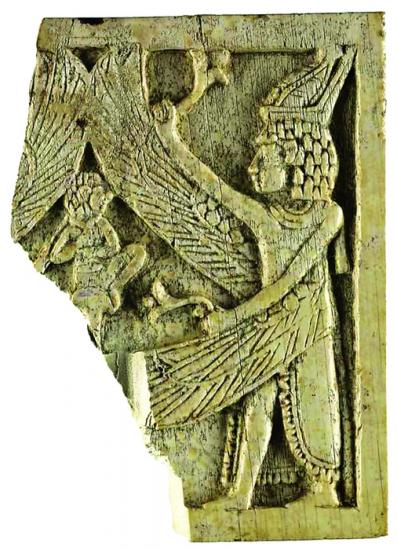Sarah Everts / American Chemical Society
Source - http://cen.acs.org/articles/91/i20/Archaeologys-Hidden-Secrets.html?utm_source=feedburner&utm_medium=feed&utm_campaign=Feed%3A+cen_latestnews+%28Chemical+%26+Engineering+News%3A+Latest+News%29

This Phoenician sculpture made of ivory was once gilded. Credit: Courtesy of Musée du Louvre/R. Chipault
Ancient ivory carvings made by Phoenician artists some 3,000 years ago have long hidden a secret, even while being openly displayed in museums around the world: The sculptures were originally painted with colorful pigments, and some were decorated with gold.
Researchers based in France and Germany report chemical analyses showing that 8th-century B.C. Phoenician ivory artifacts bear metal traces that are invisible to the naked eye (Anal. Chem. 2013, DOI: 10.1021/ac4006167).
These metals are found in pigments commonly used in antiquity, such as the copper-based pigment Egyptian blue or the iron-based pigment hematite. The metals are not normally in ivory nor in the soil where the artifacts were long buried, explains Ina Reiche, a chemist at the Laboratory of Molecular & Structural Archaeology, in Paris. Reiche led the research, which was performed on ivory originally unearthed in Syria and now held at Baden State Museum, in Karlsruhe, Germany.
Phoenicians were seafaring Semitic traders who pioneered the use of an alphabet later adopted in ancient Greece, and they controlled the valuable royal-purple pigment trade throughout the Mediterranean during the period 1500–300 B.C.
Scholars had suspected that Phoenician ivory sculptures might initially have been painted, but to date most studies had examined just a few spots on ivory surfaces, Reiche says. Her team used a synchrotron to do X-ray fluorescence spectroscopy to analyze the entire surface of the artifacts with micrometer resolution, revealing the spatial distribution of the lost pigmentation.
“Knowledge of an object’s original appearance can help us understand why it was so visually powerful to ancient viewers,” says Benjamin W. Porter, an archaeologist at the University of California, Berkeley. And there are plenty of important objects to examine, he adds. “This technique is transferable to other kinds of ancient art whose pigments have been weathered, from the palace wall reliefs of the Assyrian empire to Egyptian tomb paintings to everyday ceramic vessels whose decorations have been worn.”
Copyright © 2013 American Chemical Society